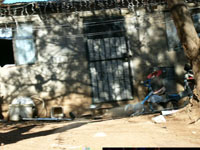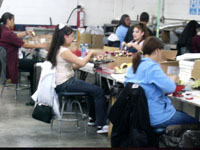
- My Home Page
- My Bio
- Family Object
- Immigrant Agency
- Border Links
- Country Poster
- City Migrants
- Crossing the Valley
- Open Letter
Open Letter to Valley Residents
Phoenix Residents,
Over the course of the spring 2005 semester, I had the opportunity to take Migration and Culture. Admittedly, the class is one of the requirements of my degree, and that was my primary motivation for registering for it. I did not imagine that I would be hearing anything I hadnít already heard, as migration is a pretty hot topic in the Valley of the Sun. There were some items we discussed that I knew about, such as how different immigrant groups will assimilate into a society differently, and that the time period will factor into assimilation as well. However, I did have some eye-opening experiences as well.
The thing that affected me
the most was our class trip to Nogales in Mexico. I myself had
previously only entered Canada for a day trip a year ago. Iíd never been
outside of the U.S. otherwise. As we entered Nogales, I was initially
struck by the amount of pedestrian traffic and the fact that most of the
stores in the shopping area of the city looked a bit run down. I was
also quite shocked and a little frightened at the road conditions and
driving there. As we ventured further into Nogales and into the
residential colonias I was struck by the state of the homes. Most were
built ramshackle with various types of materials, and they were quite
small too. The roads only got worse into the colonias, and we also had
to be careful not to hit one of the many stray dogs that abounded within
the neighborhoods. Throughout all of this, I felt like an alien in a
strange land. Iíve been to South Phoenix, where the housing is certainly
not up to code and most of the pavement is shoddy, but this was
different. In South Phoenix there are still the sites and sounds of
modern city life and traffic lights. In the colonias, it was like going
back in time, except for the other rundown cars. This was a view of
poverty that I hadnít seen.
This experience in Nogales made me truly understand the drive to migrate to the U.S. Most of us in the valley have read the stories and seen the news about the economy in Mexico. But itís difficult to equate millions of dollars and even millions of people living in poverty; the numbers are so large, we canít really comprehend it. Seeing the living conditions, and discovering that the average pay in a maquiladora is roughly $8.00 per day really drives the bleakness of the situation home. I understand what would drive someone to risk their life and try and slip through the desert just to work a terrible minimum wage job in the U.S. Those that are lucky enough to enter the U.S. through legal means donít have an easy time of it either. The wait seems eternal, the fees are astronomical when compared to the income and youíre subject to the whims of whoever happens to be interviewing you that day. Itís difficult to enter the U.S. from Mexico, legally or illegally. Yet people do it every day. Iíve now seen why they do and I think thatís what Iíll take away from this class: the memory of Nogales and why people are trying to enter the U.S.
I would encourage anyone reading this to take a visit to Mexico. But walk out beyond the shops and sidewalk vendors. Try and see what the city is really built upon: the colonias and the families laboring to survive there. I guarantee this, once you see the reality that these people live in everyday, youíll view immigration in a new way.
Thanks,
Stephanie Cleland
